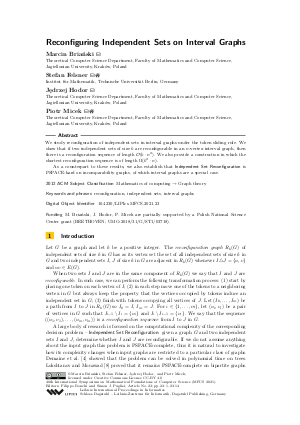Reconfiguring Independent Sets on Interval Graphs
Authors Marcin Briański, Stefan Felsner, Jędrzej Hodor, Piotr Micek
-
Part of:
Volume:
46th International Symposium on Mathematical Foundations of Computer Science (MFCS 2021)
Part of: Series: Leibniz International Proceedings in Informatics (LIPIcs)
Part of: Conference: Mathematical Foundations of Computer Science (MFCS) - License:
 Creative Commons Attribution 4.0 International license
Creative Commons Attribution 4.0 International license
- Publication Date: 2021-08-18
File

PDF
LIPIcs.MFCS.2021.23.pdf
- Filesize: 0.91 MB
- 14 pages
Document Identifiers
Subject Classification
ACM Subject Classification
- Mathematics of computing → Graph theory
Keywords
- reconfiguration
- independent sets
- interval graphs
Metrics
- Access Statistics
-
Total Accesses (updated on a weekly basis)
0PDF Downloads0Metadata Views
Abstract
We study reconfiguration of independent sets in interval graphs under the token sliding rule. We show that if two independent sets of size k are reconfigurable in an n-vertex interval graph, then there is a reconfiguration sequence of length 𝒪(k⋅ n²). We also provide a construction in which the shortest reconfiguration sequence is of length Ω(k²⋅ n). As a counterpart to these results, we also establish that Independent Set Reconfiguration is PSPACE-hard on incomparability graphs, of which interval graphs are a special case.
Cite As Get BibTex
Marcin Briański, Stefan Felsner, Jędrzej Hodor, and Piotr Micek. Reconfiguring Independent Sets on Interval Graphs. In 46th International Symposium on Mathematical Foundations of Computer Science (MFCS 2021). Leibniz International Proceedings in Informatics (LIPIcs), Volume 202, pp. 23:1-23:14, Schloss Dagstuhl – Leibniz-Zentrum für Informatik (2021)
https://doi.org/10.4230/LIPIcs.MFCS.2021.23
BibTex
@InProceedings{brianski_et_al:LIPIcs.MFCS.2021.23,
author = {Bria\'{n}ski, Marcin and Felsner, Stefan and Hodor, J\k{e}drzej and Micek, Piotr},
title = {{Reconfiguring Independent Sets on Interval Graphs}},
booktitle = {46th International Symposium on Mathematical Foundations of Computer Science (MFCS 2021)},
pages = {23:1--23:14},
series = {Leibniz International Proceedings in Informatics (LIPIcs)},
ISBN = {978-3-95977-201-3},
ISSN = {1868-8969},
year = {2021},
volume = {202},
editor = {Bonchi, Filippo and Puglisi, Simon J.},
publisher = {Schloss Dagstuhl -- Leibniz-Zentrum f{\"u}r Informatik},
address = {Dagstuhl, Germany},
URL = {https://drops.dagstuhl.de/entities/document/10.4230/LIPIcs.MFCS.2021.23},
URN = {urn:nbn:de:0030-drops-144633},
doi = {10.4230/LIPIcs.MFCS.2021.23},
annote = {Keywords: reconfiguration, independent sets, interval graphs}
}
Author Details
- Theoretical Computer Science Department, Faculty of Mathematics and Computer Science, Jagiellonian University, Kraków, Poland
- Theoretical Computer Science Department, Faculty of Mathematics and Computer Science, Jagiellonian University, Kraków, Poland
Funding
M. Briański, J. Hodor, P. Micek are partially supported by a Polish National Science Center grant (BEETHOVEN; UMO-2018/31/G/ST1/03718).
References
-
Marthe Bonamy and Nicolas Bousquet. Token sliding on chordal graphs. In Graph-Theoretic Concepts in Computer Science, Proc. WG 2017, volume 10520 of LNCS, pages 127-139. Springer, 2017.

-
Paul Bonsma, Marcin Kamiński, and Marcin Wrochna. Reconfiguring independent sets in claw-free graphs. In R. Ravi and Inge Li Gørtz, editors, Algorithm Theory, Proc. SWAT 2014, volume 8503 of LNCS, pages 86-97. Springer, 2014.

- Nicolas Bousquet. Talk at the graph theory seminar in Bordeaux, October 02, 2020. URL: https://webconf.u-bordeaux.fr/b/mar-ef4-zed.
-
Erik D. Demaine, Martin L. Demaine, Eli Fox-Epstein, Duc A. Hoang, Takehiro Ito, Hirotaka Ono, Yota Otachi, Ryuhei Uehara, and Takeshi Yamada. Polynomial-time algorithm for sliding tokens on trees. In Hee-Kap Ahn and Chan-Su Shin, editors, Algorithms and Computation, Proc. ISAAC 2014, volume 8889 of LNCS, pages 389-400. Springer, 2014.

-
Eli Fox-Epstein, Duc A Hoang, Yota Otachi, and Ryuhei Uehara. Sliding token on bipartite permutation graphs. In Algorithms and Computation, Proc. ISAAC 2015, volume 9472 of LNCS, pages 237-247. Springer, 2015.

-
Robert A. Hearn and Erik D. Demaine. Pspace-completeness of sliding-block puzzles and other problems through the nondeterministic constraint logic model of computation. Theoretical Computer Science, 343(1):72-96, 2005.

-
Marcin Kamiński, Paul Medvedev, and Martin Milanič. Complexity of independent set reconfigurability problems. Theoretical Computer Science, 439:9-15, 2012.

-
Daniel Lokshtanov and Amer E. Mouawad. The complexity of independent set reconfiguration on bipartite graphs. ACM Trans. Algorithms, 15(1):19 pages, 2018. Article No.: 7.

-
Naomi Nishimura. Introduction to reconfiguration. Algorithms, 11(4):52, 2018.

-
Marcin Wrochna. Reconfiguration in bounded bandwidth and tree-depth. Journal of Computer and System Sciences, 93:1-10, 2018.

